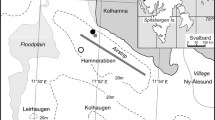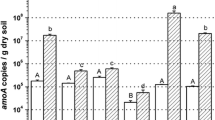Abstract
As part of a long-term sloped land use experiment established in 1995 at Taoyuan Agro-ecosystem Research Station (111°26′ E, 28°55′ N) in China, soil samples were collected from three land use types, including cropland (CL), natural forest, and tea plantation. Quantitative polymerase chain reaction and terminal restriction fragment length polymorphism were used to determine the abundance and community composition of amoA-containing bacteria (AOB) and archaea (AOA). The results indicate that land use type induced significant changes in soil potential nitrification rate and community composition, diversity, and abundance of AOB and AOA. Both AOB and AOA community compositions were generally similar between upper and lower slope positions (UP and LP), except within CL. The LP soils had significantly (p < 0.05) higher diversity and abundance of both AOB and AOA than in the UP. Potential nitrification rate was significantly correlated (p < 0.05) with diversity and abundance of AOA, but not with AOB. Among land use types, the NO3 − and amoA-containing AOA runoff loss was greatest in CL. Nitrate-N runoff loss was significantly correlated (p < 0.05) with the loss of AOA amoA copies in the runoff water. Furthermore, relationships between NO3 −-N runoff loss and abundance of AOA but not of AOB at both slope positions were significantly correlated (p < 0.05). These findings suggest that AOA are more important than AOB in nitrification and NO3 −-N runoff loss in acidic soils across sloped land use types.





Similar content being viewed by others
References
Alfreider A, Vogt C, Babel W (2002) Microbial diversity in an in situ reactor system treating monochlorobenzene contaminated groundwater as revealed by 16S ribosomal DNA analysis. Syst Appl Microbiol 25:232–240
Chen Z, Luo XQ, Hu RG, Wu MN, Wu JS, Wei WX (2010) Impact of long-term fertilization on the composition of denitrifier communities based on nitrite reductase analyses in a paddy soil. Microb Ecol 60:850–861
Chen X, Zhang LM, Shen JP, Wei WX, He JZ (2011) Abundance and community structure of ammonia-oxidizing archaea and bacteria in an acid paddy soil. Biol Fertil Soils 47:323–331
Di HJ, Cameron KC, Shen JP, He JZ, Winefield CS (2009a) Nitrate leaching from grazed grassland as affected by a nitrification inhibitor, dicyandiamide, and relationships with ammonia oxidizing bacterial and archaea. Soil Use Manag 25:454–461
Di HJ, Cameron KC, Shen JP, Winefield CS, Callaghan MO, Bowatte S, He JZ (2009b) Nitrification driven by bacteria and not archaea in nitrogen-rich grassland soils. Nature Geosci 2:621–624
Erguder TH, Boon N, Wittebolle L, Marzorati M, Verstraete W (2009) Environmental factors shaping the ecological niches of ammonia-oxidizing archaea. FEMS Microbiol Rev 33:855–869
Falkowski PG, Fenchel T, Delong EF (2008) The microbial engines that drive Earth's biogeochemical cycles. Science 320:1034–1039
Gleeson DB, Muller C, Banerjee S, Ma W, Siciliano SD, Murphy DV (2010) Response of ammonia oxidizing archaea and bacteria to changing water filled pore space. Soil Biol Biochem 42:1888–1891
Gruber N, Galloway JN (2008) An Earth-system perspective of the global nitrogen cycle. Nature 451:293–296
Gubry-Rangin C, Nicol GW, Prosser JI (2010) Archaea rather than bacteria control nitrification in two agricultural acidic soils. FEMS Microbiol Ecol 74:566–74
He JZ, Shen JP, Zhang LM, Zhu YG, Zheng YM, Xu MG, Di HJ (2007) Quantitative analyses of the abundance and composition of ammonia-oxidizing bacteria and ammonia-oxidizing archaea of a Chinese upland red soil under long-term fertilization practices. Environ Microbiol 9:2364–2374
Honda C (1962) Rapid procedure for determination of nitrogen in soil by Kieldahl method. J Sci Soil Manure 33:195–200
Hoque MM, Inubushi K, Miura S, Kobayashi K, Kim HY, Okada M, Yabashi S (2001) Biological dinitrogen fixation and soil microbial biomass carbon as influenced by free-air carbon dioxide enrichment (FACE) at three levels of nitrogen fertilization in a paddy field. Biol Fertil Soils 34:453–459
Hossain Z, Sugiyama S (2011) Geographical structure of soil microbial communities in northern Japan: effects of distance, land use type and soil properties. Eur J Soil Biol 47:88–94
Jia ZJ, Conrad R (2009) Bacteria rather than Archaea dominate microbial ammonia oxidation in an agricultural soil. Environ Manag 11:1658–1671
Jones JB (1973) Soil testing in the United States. Soil Sci Plant Anal 4:307–322
Kitts CL (2001) Terminal restriction fragment patterns: a tool for comparing microbial communities and assessing community dynamics. Curr Issues Intest Microbiol 2:17–25
Leininger S, Urich T, Schloter M, Schwark L, Qi J, Nicol GW, Prosser JI, Schuster SC, Schleper C (2006) Archaea predominate among ammonia-oxidizing prokaryotes in soils. Nature 442:806–809
Lu RK (2000) Agricultural chemical analysis method of soil. China Agriculture Science and Technology Press, Beijing, pp 107–108
Moges A, Holden NM (2008) Soil fertility in relation to slope position and agricultural land use: a case study of Umbulo Catchment in Southern Ethiopia. Environ Manag 42:753–763
Nicol GW, Leininger S, Schleper C, Prosser JI (2008) The influence of soil pH on the diversity, abundance and transcriptional activity of ammonia oxidizing archaea and bacteria. Environ Manag 10:2966–2978
Olsen SR, Cole CV, Watanabe FS, Dean LA (1954) Estimation of available phosphorus in soils by extraction with sodium bicarbonate. In: USDA Circular No. 939. U.S. Department of Agriculture, Washington, DC, pp 19
Peng N, Wang KF, Xie XL, Hu S (2008) Effects of different utilization model on soil water redistributions, runoff and nutrition loss on red sloping lands. Res Soil Water Conserv 15:207–213
Pester M, Schleper C, Wagner M (2011) The Thaumarchaeota: an emerging view of their phylogeny and ecophysiology. Curr Opin Microbiol 14:300–306
Powlson DS, Brookes PC, Christensen B (1987) Measurement of soil microbial biomass provides an early indication in total soil organic matter due to straw incorporation. Soil Biol Biochem 19:159–164
Purkhold U, Pommerening-Röser A, Juretschko S, Schmid MC, Koops HP, Wagner M (2000) Phylogeny of all recognized species of ammonia oxidizers based on comparative 16S rRNA and amoA sequence analysis: implications for molecular diversity surveys. Appl Environ Microbiol 66:5368–5382
Putjaroon W, Pongboon K (1987) Amount of runoff and soil losses from various land-use sampling plots in Sakolnakorn Province, Thailand. In: Swanson YH, Bernier PY, Woodward PD (eds) Forest hydrology and watershed management. Proc Vancouver Symp, Wallingford, UK, pp 231–238
Reed DW, Smith JM, Francis CA, Fujita Y (2010) Responses of ammonia-oxidizing bacterial and archaeal populations to organic nitrogen amendments in low-nutrient groundwater. Appl Environ Microbiol 76:2517–2523
Rotthauwe JH, Witzel KP, Liesack W (1997) The ammonia monooxygenase structural gene amoA as a functional marker: molecular fine-scale analysis of natural ammonia-oxidizing populations. Appl Environ Microbiol 63:4704–4712
Sahan E, Muyzer G (2008) Diversity and spatio-temporal distribution of ammonia-oxidizing archaea and bacteria in sediments of the Westerschelde estuary. FEMS Microbiol Rev 64:175–186
Schleper C (2010) Ammonia oxidation: different niches for bacteria and archaea? ISME J 4:1092–1094
Schmidt EL, Belser LM (1994) Autotrophic nitrifying bacteria. In: Weaver RW, Angle JS, Bottomley PS (eds) Method of soil analysis, part 2. Microbiological and biochemical properties. Soil Science Society of America, Madison, WI, pp 159–177
Sim A, Horton J, Gajaraj S, McIntosh S, Miles RJ, Mueller R, Reed R, Hua ZQ (2012) Temporal and spatial distributions of ammonia-oxidizing archaea and bacteria and their ratio as an indicator of oligotrophic conditions in natural wetlands. Water Res 46:4121–4129
Tourna M, Freitag TE, Nicol GW, Prosser JI (2008) Growth, activity and temperature responses of ammonia-oxidizing archaea and bacteria in soil microcosms. Environ Microbiol 10:1357–1364
Treusch AH, Leininger S, Kletzin A, Schuster SC, Klenk HP, Schleper C (2005) Novel genes or nitrite reductase and Amo-related proteins indicate a role of uncultivated mesophilic crenarchaeota in nitrogen cycling. Environ Microbiol 7:1985–1995
Wang J, Fu BJ, Qiu Y, Chen LD (2001) Soil nutrients in relation to land use and slope position in the semi-arid small catchment on the Loess Plateau in China. J Arid Environ 48:537–550
Webster G, Embley TM, Prosser JI (2002) Grassland management regimens reduce small-scale heterogeneity and species diversity of β-proteobacterial ammonia oxidizer populations. Appl Environ Microbiol 68:20–30
Xie XL, Wang KR (2003) Observation studies on water and soil loss in the process of rainfall on the slope lands of red soil in north Hunan. J Mt Sci 21:466–472
Xue D, Yao HY, Ge DY, Huang CY (2008) Soil microbial community structure in diverse land use systems: a comparative study using biolog, DGGE, and PLFA analyses. Pedosphere 18:653–663
Yang YS, Xin NQ (1995) Integrated development of agriculture and its countermeasure in reddish yellow soil regions of China. China Agriculture Press, Beijing
Yao HY, Gao YM, Nicol GW, Campbell CD, Prosser JI, Zhang LM, Han WY, Singh BK (2011) Links between ammonia oxidizer community structure, abundance, and nitrification potential in acidic soils. Appl Environ Manag 77:4618–4625
Yu WT, Xu YG, Bi ML, Ma Q, Zhou H (2010) Activity and composition of ammonia-oxidizing bacteria in an aquic brown soil as influenced by land use and fertilization. Pedosphere 20:789–798
Zhao GX, Li XJ, Wang RY, Li T, Yue YD (2007) Soil nutrients in intensive agricultural areas with different land-use types in Qingzhou county, China. Pedosphere 17:165–171
Acknowledgments
This research was finically supported by the National Basic Research Program of China (973 Program, 2012CB417106), the key project for the Twelfth Five-Year Plan of China (2012BAD14B03), and the National Natural Science Foundation of China (41271280, 40801098).
Author information
Authors and Affiliations
Corresponding author
Rights and permissions
About this article
Cite this article
Qin, H., Yuan, H., Zhang, H. et al. Ammonia-oxidizing archaea are more important than ammonia-oxidizing bacteria in nitrification and NO3 −-N loss in acidic soil of sloped land. Biol Fertil Soils 49, 767–776 (2013). https://doi.org/10.1007/s00374-012-0767-1
Received:
Revised:
Accepted:
Published:
Issue Date:
DOI: https://doi.org/10.1007/s00374-012-0767-1




